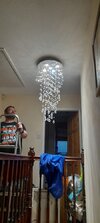- Joined
- 27 Jan 2008
- Messages
- 27,758
- Reaction score
- 3,364
- Location
- Llanfair Caereinion, Nr Welshpool
- Country

You are correct, grease on quartz, dimming quartz, using without glass to stop harmful rays, but all seem to get ignored. And I have seen wagons with broken head light glasses where the quartz bulb is encrusted with mud and still working.
Had you asked me 3 years ago I would have said I will never use quartz bulbs again, but in this house had to fit them or at least one, as the smart switch would not work with all LED bulbs, did finally find LED bulbs that did work, but for a time had to return to quartz.
I do use smart switches, smart relays, smart sockets, smart socket adaptors, smart bulbs, and smart TRV heads, as to if really required harder to answer, I was able to turn on the AC an hour before coming home yesterday, and can turn on landing lights by simply saying "hey google turn on landing light", but I have also had to remove smart light switches, and sockets which have failed, and the house is mine, so no landlord to tell me what to do.
My daughter now has worked out, turn lights off/on and it cancels a off command to smart bulb from phone, but my wife programs the zigbee, I am just a user, so if she died I would have a problem.
Also since my house I have fitted a SPD which should stop spikes killing the smart bulbs, but in rented you have not got the right to insist things like a surge protection device is fitted, so it's a cross your fingers job.
Had you asked me 3 years ago I would have said I will never use quartz bulbs again, but in this house had to fit them or at least one, as the smart switch would not work with all LED bulbs, did finally find LED bulbs that did work, but for a time had to return to quartz.
I do use smart switches, smart relays, smart sockets, smart socket adaptors, smart bulbs, and smart TRV heads, as to if really required harder to answer, I was able to turn on the AC an hour before coming home yesterday, and can turn on landing lights by simply saying "hey google turn on landing light", but I have also had to remove smart light switches, and sockets which have failed, and the house is mine, so no landlord to tell me what to do.
My daughter now has worked out, turn lights off/on and it cancels a off command to smart bulb from phone, but my wife programs the zigbee, I am just a user, so if she died I would have a problem.
Also since my house I have fitted a SPD which should stop spikes killing the smart bulbs, but in rented you have not got the right to insist things like a surge protection device is fitted, so it's a cross your fingers job.

